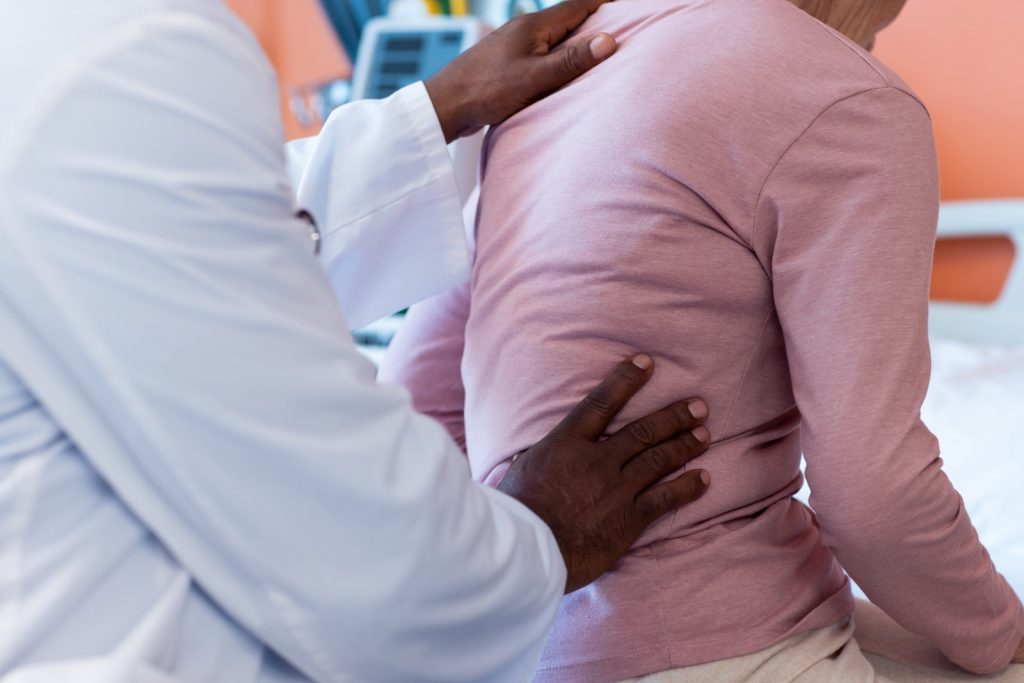Upper Back Pains
Are you plagued by constant upper back pain that makes it difficult to sit, stand, or even sleep? You’re not alone. Upper back pain can be a real nuisance, affecting your daily life and productivity. Whether you’re experiencing sharp, shooting pains or a dull, constant ache, finding relief is essential.
Causes of Upper Back Pains:
Upper back pain can have various causes, and understanding them is crucial in finding effective relief.
- One common cause is poor posture, particularly when sitting or standing for extended periods with a rounded back. This can strain the muscles and ligaments in the upper back, leading to discomfort and pain.
- Muscle strain is another frequent culprit. Overexertion, heavy lifting, or sudden movements can strain the muscles in the upper back, causing pain and stiffness.
- Additionally, spinal issues like herniated discs or degenerative conditions can contribute to upper back pain, as the nerves in the area may become compressed or irritated.

Common Symptoms and Signs of Upper Back Pains:
Recognizing the symptoms and signs of upper back pain is essential for proper diagnosis and treatment.
- The most obvious symptom is pain in the upper back region, ranging from a dull ache to sharp, shooting sensations. This discomfort may worsen with certain movements or activities.
- Other typical signs include stiffness, limited range of motion, and muscle spasms in the upper back area.
- You may also experience tension headaches or pain radiating down your arms. It’s important to pay attention to these symptoms and consult a healthcare professional for an accurate diagnosis.
How to Prevent Upper Back Pains?
Prevention is key when it comes to upper back pain. By adopting healthy habits and making simple changes to your daily routine, you can minimize the risk of developing discomfort in the upper back area.
- One crucial step is maintaining good posture, whether sitting, standing, or even sleeping.
- Investing in an ergonomic chair or using back supports can provide additional support and promote proper spinal alignment.
- Regular exercise, particularly focusing on strengthening the back and core muscles, can also help prevent upper back pain.
- Additionally, taking breaks to stretch and move throughout the day can alleviate muscle tension and reduce the risk of developing pain.
Exercises and Stretches for Upper Back Pain Relief:
Exercise can be an effective way to alleviate upper back pain and strengthen the surrounding muscles. Here are a few exercises and stretches that can provide relief:
- Upper Back Stretch: Stand tall with your feet shoulder-width apart. Interlace your fingers and stretch your arms forward, rounding your upper back. Hold for 30 seconds, then release.
- Cat-Cow Stretch: Start on all fours with your hands and knees shoulder-width apart. Arch your back upwards (cat pose), then lower it downwards (cow pose). Repeat this movement for 10 repetitions.
- Shoulder Blade Squeeze: Sit or stand with your arms by your sides. Squeeze your shoulder blades together, hold for 5 seconds, and release. Repeat this exercise 10 times.
Remember to listen to your body and stop any exercise that causes pain or discomfort. It’s always a good idea to consult with a healthcare professional or physical therapist before starting a new exercise routine.
When to Seek Medical Help for Upper Back Pains:
If the pain is severe, persistent, or accompanied by other symptoms like numbness, tingling, or difficulty breathing, it’s crucial to seek immediate medical help.
Furthermore, if the pain is a result of an injury, accident, or sudden trauma, it’s important to consult a healthcare professional for a proper evaluation and treatment plan. They can provide a comprehensive diagnosis and recommend appropriate interventions to alleviate your upper back pain.
Treatment Options for Upper Back Pains:
The treatment options for upper back pain vary depending on the underlying cause and severity of the condition.
- For mild cases, self-care measures like rest, gentle stretching, and over-the-counter pain medications may be sufficient. However, if the pain persists or worsens, medical interventions may be required.
- Physical therapy can be highly effective in relieving upper back pain. A trained therapist can guide you through specific exercises and techniques to improve strength, flexibility, and posture.
- In more severe cases, a healthcare professional may recommend medications, injections, or even surgery to alleviate the pain and address the underlying cause.

Contact Us
Upper back pain can interfere with daily activities and overall quality of life. If you’re experiencing discomfort in your upper back, book an appointment with Dr. Burhan for a thorough evaluation and customized treatment plan. Dr. Burhan specializes in diagnosing and treating upper back issues, using state-of-the-art methods to relieve pain and improve mobility. Don’t let upper back pain disrupt your routine—schedule your consultation with Dr. Burhan today and take the first step towards relief and recovery.


